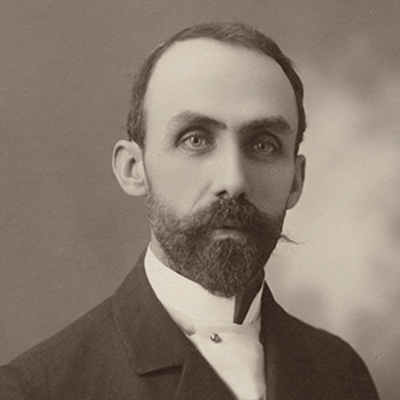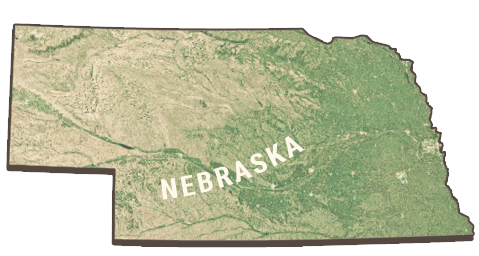
Erwin Hinckley Barbour was a paleo sleuth who trained under another paleo sleuth, O.C. Marsh. His creativity and insight that enabled Barbour to make a name for himself and helped put Nebraska firmly on the paleontology map, while vastly enriching our understanding of elephant evolution.
E.H. Barbour came to the University of Nebraska to serve as director of the state museum.
Barbour arrived in 1891. A history of the museum written by George Corner quotes then-Chancellor Canfield’s description of the museum: “(I)t consisted of a skeleton of a horse and a cow.”
Barbour recognized that the museum lacked direction and that the wonderful fossil resources of Nebraska were all leaving the state for big museums back east.
Barbour decided to build the collections through a series of student expeditions--at his own expense. They studied formations and collected specimens which became the initial collections of the present-day University of Nebraska Museum.
By 1893, Barbour once wrote, the museum was so full the floors sagged and a wall had to be replaced.
The work caught the attention of Regent Charles H. Morrill, who became a patron of Barbour’s expeditions. Later, Childs Frick also funded fossil-gathering trips that filled the museum’s display cases.
Dr. Henry Fairfield Osborn, president of the American Museum of Natural History, visited and praised the museum as a wonderful achievement. Osborn stated, “No where [sic] in the world today has any state or country an exhibition to compare with this.” Osborn was particularly impressed with the “shovel tuskers” and “dredge tuskers” displayed in the “elephant gallery.”
Because Barbour was a professor in the geology department and was already receiving a salary for that, he was never paid for being director of the museum. But he loved the work. On the morning of the day he died, he was planning research for the summer ahead.
E.H. Barbour's fossil discoveries and careful scholarship helped tell the amazing tale of not only the evolution but the migration of what we now know as elephants.

Barbour traveled to western Nebraska, the Badlands, the Black Hills of South Dakota, and eastern Wyoming. His discoveries of fossil elephants from the Miocene of Nebraska led to the current understanding that elephants first ventured from Asia to North America about 14 million years ago and quickly diversified in forms as they adapted to their new home.
Barbour was very interested in the growing number and types of ancient elephants being found in Nebraska. He devoted much of his career to discovering and describing fossil elephants, including gomphotheres (also called “four tuskers” or “shovel tuskers”), mastodons, stegomastodons, and mammoths. Barbour oversaw the installation of displays of fossil elephants, many his own discoveries, in Morrill Hall of the State Museum. Elephant Hall became the largest in number and variety of fossil elephant skeletons on display in one room in the world!
This is a gomphothere, on exhibit at the Denver Museum of Nature and Science. (Note: The gomphothere and the rhinoceros to its right both have a Nebraska connection: they were collected by Morris Skinner in Brown County, Nebraska, in 1928. Most of the fossils Morris collected went to the University of Nebraska or American Museum of Natural History.)
Here are just a few of the samples Barbour collected. Use the 3D models to see what he saw:
In addition to being a brilliant paleo sleuth, E.H. Barbour was a gifted artist who was able to combine his keen observation of fossil specimens, his extensive knowledge of biology, and his rich imagination to create images of prehistoric animals and plants as they might have looked when they were alive. Barbour art below is © University of Nebraska State Museum.
Carrie Barbour was the sister of E. H. Barbour and was one of the first women to become a paleontologist. While growing up in Oxford, Ohio, she had a special interest in natural history, but studied ceramics and woodcarving. She attended Oxford Female College, then taught art for two years in Grinnell, Iowa. In 1892, she joined the art faculty at the University of Nebraska Lincoln, where her brother was a professor of geology. While teaching in the art department, she became so involved with helping her brother create the State Museum she resigned from the art department and concentrated on paleontological work. She also pursued graduate studies in biology.
She became assistant curator of the museum in 1893, and worked for the museum for nearly 50 years. She took part in fossil discoveries, including a visit to a cellar excavation on U Street in Lincoln that turned up bones from a mammoth. But she was also part of the Morrill Geological Expeditions, traveling with the crews to locations in South Dakota, Wyoming, and Nebraska. In 1899, working with an assistant professor, she collected specimens of many species from the Nebraska Carboniferous and Permian formations. Many of the 20,000 specimens they collected during that summer were common, but three or four had not been described previously. Carrie Barbour did not publish extensively, but as an assistant professor, she taught paleontology for 25 years. Her research work aided in the identification of many fossils, and her contribution to the success of the museum was considerable.
Morrill Hall is famous for elephants, but if you visit the State Museum, you’ll find the founders of the museum also loved dogs. In the life-sized portrait of museum patron Charles Morrill hanging in one of the galleries, Morrill is seen with the Blue River in the background and a small black dog at his feet. The nearby portrait of Morrill’s wife Harriet shows her relaxing on the porch of their Stromsburg home with some bigger canines lounging with her.
In the same gallery, the portrait of E. H. Barbour is dog-free, but still, Barbour cared deeply for his own pooch, a black cocker spaniel named Waggles. The spaniel was Barbour’s first and only dog. Waggles lived to be 17, but became senile and had to be put to sleep. Barbour entered the dog’s skeleton into the Museum’s accession book (the record of what is being added to or removed from the museum’s collections) in 1914, with the postscript, “Love me, love my dog.”